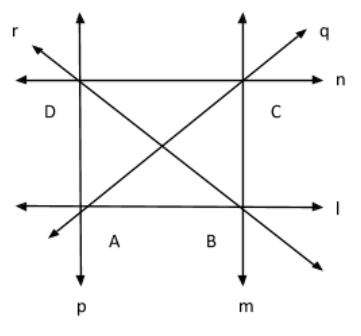
In figure, name four non-collinear points.


Answer
508.8k+ views
Hint: In Euclidean geometry, collinear points are points that all lie on the same line, whether they are close together, far apart, or form a ray, line segment, or line.
Three or more points a, b and c are said to be collinear if they lie on a single straight line L . A line on which points lie, especially if it is related to a geometric figure such as a triangle, is sometimes called an axis.
Similarly, non-collinear points are points that do not lie in the same line, whether they are close together, far apart, or form a ray, line segment, or line.
Complete step-by-step answer:
As mentioned in the question, we know the difference between collinear and non-collinear points.
Hence, using this information we can see in the figure that the four points which are non-collinear points are
A, B, C and D.
Hence, these points are the non-collinear points in the given figure.
Note: The students can make an error if they do not know the basic difference between non-collinear and collinear points.
Three or more points a, b and c are said to be collinear if they lie on a single straight line L . A line on which points lie, especially if it is related to a geometric figure such as a triangle, is sometimes called an axis.
Similarly, non-collinear points are points that do not lie in the same line, whether they are close together, far apart, or form a ray, line segment, or line.
Complete step-by-step answer:
As mentioned in the question, we know the difference between collinear and non-collinear points.
Hence, using this information we can see in the figure that the four points which are non-collinear points are
A, B, C and D.
Hence, these points are the non-collinear points in the given figure.
Note: The students can make an error if they do not know the basic difference between non-collinear and collinear points.
Recently Updated Pages
Master Class 9 General Knowledge: Engaging Questions & Answers for Success

Master Class 9 English: Engaging Questions & Answers for Success

Master Class 9 Science: Engaging Questions & Answers for Success

Master Class 9 Social Science: Engaging Questions & Answers for Success

Master Class 9 Maths: Engaging Questions & Answers for Success

Class 9 Question and Answer - Your Ultimate Solutions Guide

Trending doubts
Fill the blanks with the suitable prepositions 1 The class 9 english CBSE

How do you graph the function fx 4x class 9 maths CBSE

Difference Between Plant Cell and Animal Cell

What is pollution? How many types of pollution? Define it

What is the color of ferrous sulphate crystals? How does this color change after heating? Name the products formed on strongly heating ferrous sulphate crystals. What type of chemical reaction occurs in this type of change.

Distinguish between Conventional and nonconventional class 9 social science CBSE




